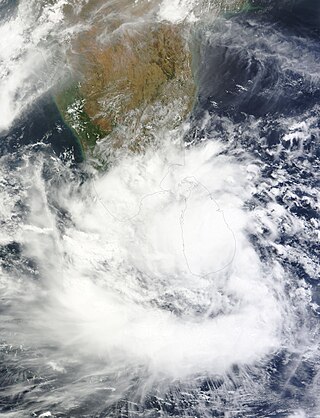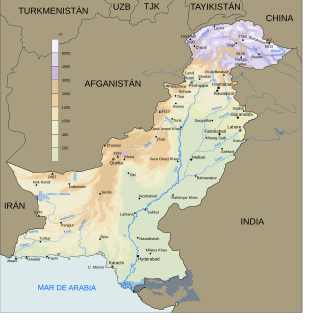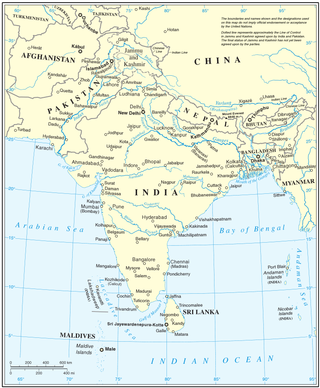| Date | 12 March - December 2019 |
|---|---|
| Location | |
| Cause | Heavy monsoon rains |
| Deaths | 2,499 |
| Non-fatal injuries | 28 |
| Missing | 70 |
In mid-March 2019, monsoonal downpours caused widespread flooding and landslides across South Asia.
| Date | 12 March - December 2019 |
|---|---|
| Location | |
| Cause | Heavy monsoon rains |
| Deaths | 2,499 |
| Non-fatal injuries | 28 |
| Missing | 70 |
In mid-March 2019, monsoonal downpours caused widespread flooding and landslides across South Asia.
Heavy rains battered Bangladesh beginning in early July, with the monthly rainfall in Cox's Bazar reaching 585 mm (23.0 in) by July 14. [1] Hundreds of makeshift tents collapsed in the Kutupalong and Nayapara refugee camps in Cox's Bazar. At least two children drowned in floods and 40,000 families were affected in the camps. [2] [3] Throughout the Chittagong Division, 200 villages flooded, affecting an estimated 500,000 people. [4] Lightning killed at least 12 people, mostly rural farmers, on 13 July. [2] Cyclone Matmo-Bulbul killed around 25 people in November. [5]
Floods in March killed at least 80 people. The same floods also caused damage in neighbouring Iran. [6] A further 24 people were killed in May., [7] with five more people dying in the next month. [8]
Heavy rains in Guilin flooded the city; 300 people required rescue. Door-to-door searches were conducted in Xingping Town. [9]
From June to October, over 2,100 people died in floods across India. [10] The country recorded its heaviest rainfall since 1994. [10] In Assam, flooding along the Himalayan border with Nepal killed at least 14 people and affected approximately 1.5 million people. [2] [4] The Brahmaputra River overtopped its banks in numerous locations, flooding 1,800 villages. [9] The Assam State Disaster Management Authority (ASDMA) stated on 16 July 2019, that flooding had affected 32 of the state's 33 districts, affecting 4.496 million people across 4,620 villages. The ASDMA stated that 19 people had died due to the flooding, including two people killed by landslides, and that over 101,000 people had taken refuge at 226 relief camps and 562 relief distribution centre had been established. Over 90% of Kaziranga National Park was flooded, forcing animals to escape to the hills of Karbi Anglong district. Divisional Forest Officer Rohini B. Saikia stated that two one-horned rhinos and one elephant had drowned in the floods. Thirty animals were rescued and taken to the Centre for Wildlife Rehabilitation and Conservation for treatment. [11]
Heavy rains began on 12 July, causing flooding and landslides across Nepal. Rivers quickly eroded embankments and flooded nearby communities, notably along the Karnali, Mohana, Kandra Kanda, and Khutiya rivers. The Koshi river swelled to dangerous levels, threatening the community of Chilaiya. [12] During the overnight of 13–14 July, all 56 gates along the Koshi Barrage were opened, releasing water at 10,505 m3 (371,000 ft3) per second. [4] Numerous landslides blocked roads, leaving communities cut off and vehicles stranded. [12] At least 55 people died and 30 others were reported missing. Thirty-three people were treated for injuries. Adverse weather conditions and damaged infrastructure hampered rescue efforts. [4]
At least 1,100 people were rescued and an estimated 10,000 had been displaced from their homes. [9] Nepal police deployed 27,380 personnel nationwide. [13]
From February to April 2019, widespread flash flooding affected large parts of Pakistan, most severely in Balochistan, KPK, Punjab, and other provinces. Pakistan had been hit by three major waves of rain and flooding over the course of more than one month. The first wave of rain began on 20 February, leading to flooding in to Khyber and Balochistan, therefore, many villages and several cities had been evacuated, and more than 1,500 families had been rescued alone in Balochistan and many in other states. [14]
September floods in Sri Lanka were caused by heavy torrential rainfalls during September 2019. [15] As of 26 September 2019; the monsoon floods affected 13 districts, killing at least 2 people, injuring 6 others, and about 116,000 people were affected. [16] One casualty was reported in the Galle District and the other one was reported in Kolonnawa, where a teenager drowned in the flood water. [17] About 282 houses were reported to have been damaged, mainly in Galle and Matara, while about 15% of houses were completely destroyed in the two districts. [18] [19] A red alert was issued to areas which were situated near rivers such as Diyawanna Oya, Nilwala Ganga, Kalu Ganga, and Gin Ganga. [20] Several roads in Galle were inundated due to the overflow of rivers. [21] Colombo, Negombo, and Gampaha were also severely affected due to heavy floods. [22]

The 2003 North Indian Ocean cyclone season was the last season that tropical cyclones were not publicly labeled by India Meteorological Department (IMD). Also was mostly focused in the Bay of Bengal, where six of the seven depressions developed. The remaining system was a tropical cyclone that developed in the Arabian Sea in November, which was also the only system that did not affect land. There were three cyclonic storms, which was below the average of 4–6. Only one storm formed before the start of the monsoon season in June, although it was also the most notable. On May 10, a depression formed in the central Bay of Bengal, and within a few days became a very severe cyclonic storm. After it stalled, it drew moisture from the southwest to produce severe flooding across Sri Lanka, killing 254 people and becoming the worst floods there since 1947. Damage on the island totaled $135 million (2003 USD). The storm eventually made landfall in Myanmar on May 19. It is possible that the storm contributed to a deadly heat wave in India due to shifting air currents.

Pakistan's climate varies from a continental type of climate in the north (Gilgit-Baltistan,Kashmir,KPK), a mountainous dry climate in the west (Baluchistan), a wet climate in the East (Punjab) an arid climate in the Thar Desert, to a tropical climate in the southeast (Sindh), characterized by extreme variations in temperature, both seasonally and daily, because it is located on a great landmass barely north of the Tropic of Cancer.
This is a list of notable recorded floods that have occurred in India. Floods are the most common natural disaster in India. The heaviest southwest, the Brahmaputra, and other rivers to distend their banks, often flooding surrounding areas.

Cyclonic Storm Roanu was a relatively weak tropical cyclone that caused severe flooding in Sri Lanka and Bangladesh during May 2016. It is the first tropical cyclone of the annual cyclone season. Roanu originated from a low-pressure area that formed south of Sri Lanka, which gradually drifted north and intensified into a cyclonic storm on 19 May. However, wind shear and land interaction caused it to weaken slightly, before reintensifying as it accelerated towards the coast of Bangladesh.

Beginning on 14 May 2016, a low pressure area over the Bay of Bengal caused torrential rain to fall across Sri Lanka, causing floods and landslides which affected half a million people. As of 25 May 2016 the death toll was 101 with 100 missing.
The 2017 Sri Lanka floods resulted from a heavy southwest monsoon, beginning around 18 to 19 May 2017. Flooding was worsened by the arrival of the precursor system to Cyclone Mora, causing flooding and landslides throughout Sri Lanka during the final week of May 2017. The floods affected 15 districts, killed at least 208 people and left a further 78 people missing. As of 3 June, 698,289 people were affected, while 11,056 houses were partially damaged and another 2,093 houses completely destroyed. According to Al Jazeera, about 600,000 people have been displaced due to the floods.
Widespread monsoon flooding occurred in the South Asian countries of Afghanistan, Bangladesh, India, Nepal and Pakistan from July through September 2017. More than 45 million people were affected by the floods, including 16 million children.
2018 Sri Lanka floods and landslides caused from an annual heavy southwest monsoon beginning around 19 May. As of 26 May 2018; the monsoon floods affected in about 19 districts, killed at least 21 people, about 150, 000 people were affected and further left approximately 23 people missing. The death casualties were reported from 22 May onwards in the provinces including South, Northwest, North and East. About 4 people were reported dead due to lightning, 5 people were killed due to floods and lightning, 8 people died due to drowning and further left 4 people dead resulting from fallen trees. The DMC report claimed about 400, 000 people have been displaced to safer locations. About 105 houses were reported to have fully damaged and over 4832 houses have been partially damaged.
The 2019 Indian floods were a series of floods that affected over thirteen states in late July and early August 2019, due to excessive rains. At least 200 people died and about a million people were displaced. Karnataka and Maharashtra were the most severely affected states. People died but many were rescued with the help of the Indian Navy.
The 2019 floods and landslides in Sri Lanka were the floods which were caused from heavy torrential rainfalls during September 2019. As of 26 September 2019; the monsoon floods affected in about 13 districts, killing at least 2 persons, injuring 6 people and about 116, 000 people are affected. One casualty was reported in the Galle District and the other one was reported in Kolonnawa, where a teenager drowned in the flood water. About 282 houses were reported to have been damaged mainly in Galle and Matara while 22 houses out of 150 houses were completely destroyed in the two districts.

2020 Assam floods refers to the significant flood event of the Brahmaputra River in the Indian north-eastern state of Assam and coincided with the COVID-19 pandemic. Initial flooding started in May 2020 due to heavy rainfall affecting 30,000 and destroying crops across 5 districts. As of October 2020 the floods affected over five million people, claiming the lives of 123 people, with an additional 26 deaths due to landslides, 5474 villages were affected and over one hundred and fifty thousand people found refuge in relief camps.
The 2021 floods and landslides in Sri Lanka are flash floods and mudslides which were caused from heavy torrential rainfalls during May and June 2021. As of 7 June 2021; the monsoon floods affected in about 10 districts, killing at least 17 persons including about 10 because of floods and 4 people because of mudslides. About 245,000 people were affected living in Colombo, Puttalam, Kandy, Kalutara, Kurunegala, Gampaha, Nuwara Eliya, Ratnapura and Galle. More than 800 houses were reported to have been damaged.

In 2016 Pakistan experienced higher rainfall than normal (10-20%), especially in the pre-monsoon season. Heavy monsoon rains are common in the region. This led to multiple periods of flooding, landslides, and damage particularly in Northern Pakistan. The Swat River overflowed and multiple landslides occurred around Pakistan including in Khyber Pakhtunkhwa, Gilgit-Baltistan, Azad Jammu, and Kashmir.

The following is a list of weather events that occurred on Earth in the year 2014. There were several natural disasters around the world from various types of weather, including blizzards, cold waves, droughts, heat waves, tornadoes, and tropical cyclones. In September, floods in India and Pakistan killed 557 people. The costliest single event was Typhoon Rammasun, which killed 225 people and left over US$8 billion in damage when it moved through the Philippines, China, and Vietnam.

From January to October 2022, excessive rainfall and widespread monsoon flooding occurred in the South Asian countries of Afghanistan, Bangladesh, India, Nepal, Pakistan, and Sri Lanka. It has become the region's deadliest floods since 2020, with over 4,700 people dead.

After over 6,500 people died in flooding in 2020, monsoon floods hit South Asia again in 2021.

Flooding affected parts of South Asia since March of 2023, killing many and destroying buildings.
The 2024 Sri Lanka floods were a natural disaster resulting from heavy monsoon rains, causing flash floods, mudslides, and falling trees. The floods killed at least 16 people and affected 20 out of the country's 25 districts, with some areas reporting over 400 mm (16 in) of rain. At least five people were injured by mudslides in Ratnapura, over 12,000 homes were damaged, and over 6,000 people needed to be evacuated.